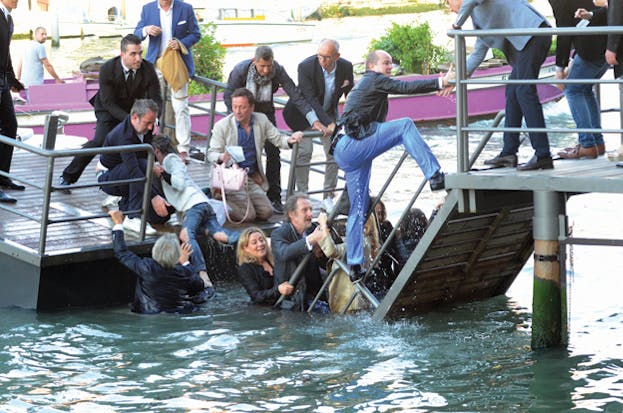Usually during the opening days of the Venice Biennale, the only liquid you get drenched in is prosecco. But before these collectors and opportunists could make it to the cocktail waiters inside the Fondazione Prada, the jetty gave way, dumping them into the Grand Canal like a bunch of Anabaptists. In this photograph, the victims (too grand a word?) all seem unharmed, and several are smiling as they cling to the buckled pier. The fellow in soaked blue trousers and the couple half-submerged look rather like the shipwrecked sailors in Géricault’s Raft of the Medusa—a jumble of limbs enmeshed on an improvised, barely seaworthy barge—as they clamber to dry land, sodden but relieved. Funny that only the security staff is in art-world-approved black, and no one seems to be wearing any of Prada’s ugly-chic dresses or 1970s-style suits. One gent has been left holding a vulgar pink handbag, while the visitor climbing back onto the left-hand dock wears jeans torn to shreds. Did they rip in the accident, or, horrifyingly, was that a reception outfit? In the background, a purple barge coasts by; the pilot looks bemused, and in no mood to help. Venice is sinking; the waters are rising; perhaps this image is a preview of the great final judgment when contemporary art and the money it attracts are all washed away.

LOCATION: Venice, Italy DATE: May 6, 2015 PHOTOGRAPHER: Gianfranco Tagliapietra
As the art market has climbed to unprecedented heights, the crowds at events like the Venice Biennale have grown as well; even noncommercial events like museum retrospectives and conferences have turned into selling opportunities, or at least marketing prospects. And the luxury industry has taken notice—inviting artists to collaborate with designers, sponsoring parties and viewings around art fairs, and, increasingly, opening their own museums and institutions for contemporary art. Elsewhere in Venice this May, there were contemporary art events sponsored by Marni, Rolls-Royce, Louis Vuitton, and more—though the Fondazione Prada, a more serious collecting institution founded in 1993 and faithful to its creator’s off-center philosophical spirit, actually mounted a show of antiquities.
In 2005, the artists Elmgreen & Dragset opened an ersatz Prada store by the side of the highway near the minimalist sanctuary of Marfa, Texas—even the middle of the Chihuahuan Desert, they implied, was not immune from Pradaization. An irony, this. Miuccia Prada is, after all, not just the most intellectual of the world’s major fashion designers. (She has a Ph.D. in political science, and her interviews are studded with Hegelian aphorisms.) She’s also a former member of the Italian Communist Party and can often seem unimpressed by her own clientele. “If I make objects that are absolutely beautiful but too sophisticated, you don’t want them,” Prada told Corriere della Sera this April. The image of the art world in the drink delighted a whole lot of observers far from Venice—certain that contemporary art has receded into an amusement for the 1 percent. But you have to imagine that inside the palazzo, in her intentionally drab skirt and flats, Miuccia was smiling, too.
